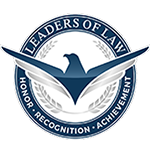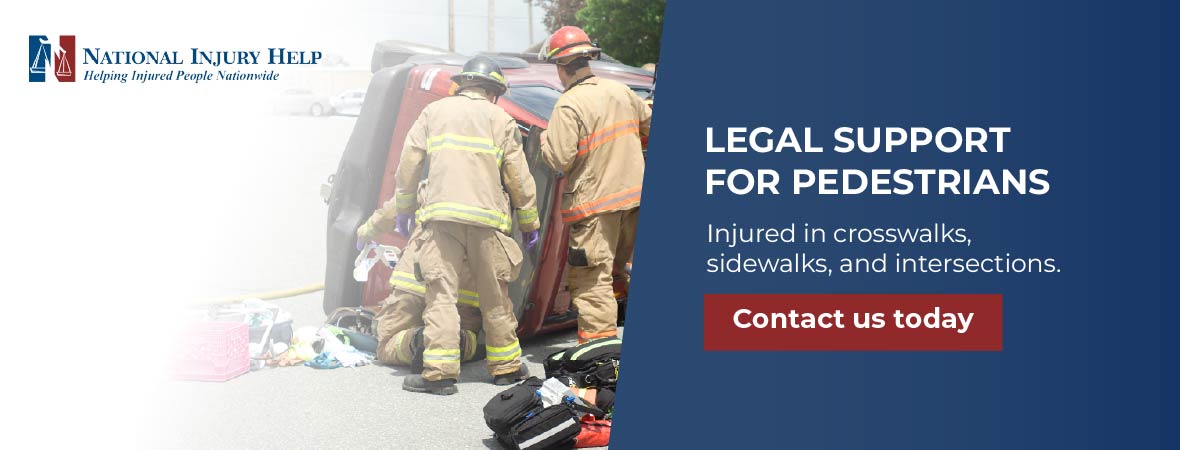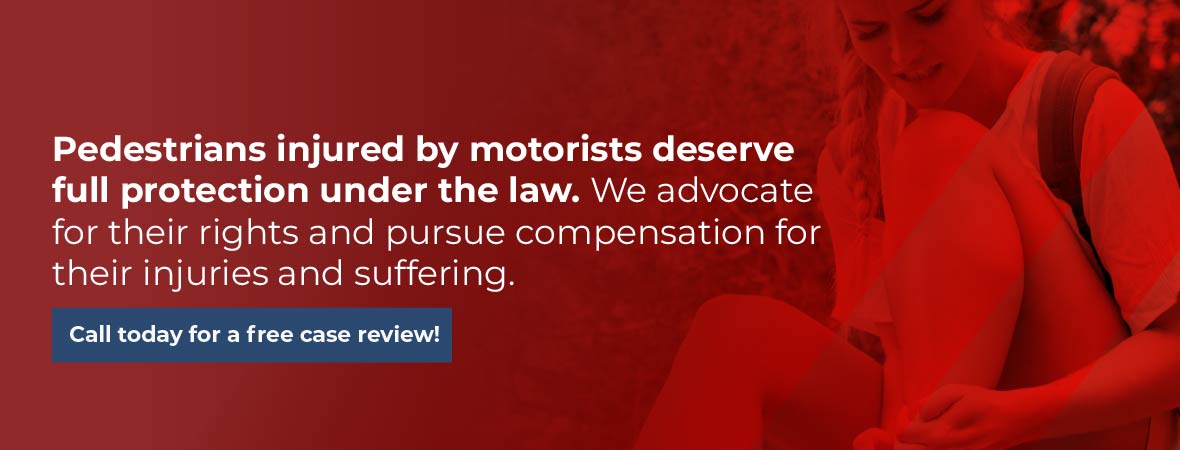If you were hit while walking or crossing the street, you have legal rights. This article explains what to do after a pedestrian accident and how to hold the driver accountable. National Injury Help is here to make sure you are not left alone to face medical bills and insurance companies.
If you were hit while walking or crossing the street, you have legal rights. This article explains what to do after a pedestrian accident and how to hold the driver accountable. National Injury Help is here to make sure you are not left alone to face medical bills and insurance companies.
Every day, across cities big and small, people head out on foot, to work, to school, to run errands, or just to get some fresh air. But in recent years, walking has become riskier. In 2023 alone, more than 7,300 pedestrians were struck and killed by drivers across the United States.
That number is slightly lower than the year before, but still far above what we saw before the pandemic. And while the causes vary, certain patterns stand out: larger vehicles like SUVs are involved in more fatal collisions, nighttime accidents are especially deadly, and distractions, on both sides of the windshield, continue to fuel the danger.
What doesn’t always show up in those statistics is the personal fallout. A pedestrian accident can flip your life upside down. You might miss work, face mounting medical bills, or suddenly need help with everyday tasks.
That’s why it’s so important to understand your legal pedestrian rights. This guide explains what you need to know if you’ve been hit while walking, jogging, or crossing the street, whether the accident happened in a quiet neighborhood or a crowded downtown.
At National Injury Help, we’ve worked with clients all over the country, and while every case is different, the key legal protections are the same. We’re here to help you take the first steps toward recovery and justice.
Common Causes of Pedestrian Crashes
American roads did not become dangerous overnight, and no single villain explains every collision. Instead, several risk factors add up in the same unhappy way, from coast to coast.
- Distracted or Impaired Driving: Smartphones demand attention at red lights, and many drivers never fully refocus when green returns. Weekend nightlife zones, from Austin’s Sixth Street to Miami’s Brickell, still see alcohol-related crashes long after last call. Roughly one-third of fatal pedestrian accidents nationwide involve a driver who was either drunk or high.
- Excessive Speed: A car traveling 40 miles per hour leaves a pedestrian with only about a one-in-four chance of survival when struck. Go just 10 miles faster, and the fatal odds triple. Suburban arterials often post 45 mph limits even though they cut through housing tracts, school zones, and strip malls.
- Failure to Yield at Crosswalks: The law in every state gives pedestrians the right of way in marked crosswalks, yet many drivers roll through right turns on red or surge left the moment oncoming traffic clears. Multi-lane roads add a lethal twist: one motorist stops, blocking the view of a second lane where another driver keeps moving.
- Weak or Aging Infrastructure: Sidewalk gaps force walkers onto the shoulders. Long signal cycles tempt mid-block “quick dashes.” Dim streetlights hide dark clothing. Cities like Denver, Charlotte, and Orlando are pouring money into Vision Zero programs, but upgrades take years to reach every corner.
- Risky Pedestrian Choices: Not every crash is solely a driver’s fault. Tourists sprint across Las Vegas Boulevard to escape the heat, college students thread between rideshare queues near campuses, and commuters jaywalk to catch buses. Even so, once a person is visible in the roadway, drivers almost always retain a legal duty to slow down.
Your Legal Rights After a Pedestrian Injury
Healing is half medical and half legal. There are a lot of pedestrian accident legal options you should explore after an injury.
1. The Right to Seek Compensation
If a driver’s negligence hurts you, civil law in every state lets you demand money for:
- Medical bills you have already received and those you reasonably expect later, such as follow-up surgery or physical therapy.
- Lost income during recovery, plus future earnings reduction if permanent injuries limit your career.
- Pain and suffering, a catch-all label for ongoing discomfort, loss of mobility, sleep disruption, and the grind of daily tasks that suddenly take twice as long.
- Emotional distress, like anxiety crossing streets, nightmares, or depression, brought on by forced lifestyle changes.
2. Comparative Fault Rules
Most states follow either pure or modified comparative negligence. Pure systems (for example, in California and New York) let you collect even if you are 90 percent at fault, but the final award drops by that same percentage.
Modified systems (used in Texas, Georgia, and many others) bar recovery once your share reaches 50 or 51 percent. A few places, such as Maryland and the District of Columbia, still cling to contributory negligence, which wipes out compensation if you played any part in the crash. Knowing the rule that applies in the court where your case will be filed is crucial.
3. Insurance and Lawsuit Options
- The driver’s liability policy is the first source of payment. Minimum limits range from ten thousand dollars in parts of the South to fifty thousand or more in Northeastern states, but serious injuries often exceed those caps.
- Uninsured or underinsured motorist (UM/UIM) coverage on your own auto policy can fill shortfalls if you carry it.
- Health insurance pays medical costs up front and later asserts reimbursement against any settlement.
- Third-party claims may target a city that failed to fix a broken signal, a construction firm that blocked sidewalks without warning, or a restaurant that served alcohol to a visibly intoxicated patron.
4. The Statute of Limitations
Deadlines vary widely. Some states set two years for personal injury lawsuits, others allow three or even six. Claims against government agencies often require written notice in as little as six months. Miss the window, and the strongest facts will not revive your case.
Steps to Take Immediately After a Collision
Seconds matter for both health and evidence. If you are conscious:
- Call 911 without delay. You need medical triage and an official report.
- Stay still if you feel back or neck pain. EMTs have the training and equipment to prevent further harm.
- Gather quick evidence with your phone. Capture license plates, vehicle type, weather, traffic signals, and your injuries. A thirty-second voice memo describing what happened can preserve fresh details.
- Collect driver and witness information while the police are on the way. Photos of licenses and business cards avoid handwritten errors.
- Seek a full medical evaluation even if you walk away. Adrenaline masks injuries, and medical records create a time-stamped link between the crash and later symptoms.
- Notify your insurance carrier promptly if you have UM or UIM. Many policies require early notice.
- Start a recovery journal. Note pain levels, missed workdays, mood swings, and tasks you need help with. Authentic daily entries often sway adjusters and juries.
Types of Pedestrian Injury Compensation
Economic losses are the easy part to measure: hospital charges, therapy invoices, prescription costs, and pay stubs. Non-economic losses deal with life’s intangibles: the panic that sets in at every crosswalk, the hobby you dropped because standing hurts, the birthday party you skipped because crowds feel dangerous now.
Courts also allow punitive damages in exceptional cases, usually where the driver’s conduct was wildly reckless, like street racing in a school zone or driving drunk after multiple prior DUI arrests. Punitive awards punish and deter rather than compensate, so they are uncommon, but they can be large.
How Shared Fault Really Plays Out
Imagine a jury values your harm at five hundred thousand dollars. They decided the driver was texting, but you crossed on a flashing “Don’t Walk,” so the blame is split 70–30. In a pure comparative state, you take home three hundred fifty thousand. In a modified state with a 50 percent cutoff, you still recover.
If the split were 55–45 against you, the same modified rule could drop your payout to zero. Small percentage shifts equal huge real-world dollars; an expert accident reconstruction can move that needle in your favor.
Evidence That Wins or Loses Cases
Some important pieces of evidence can go a long way in determining the outcome of your case.
- Police dashcam and bodycam video often captures statements drivers make before rehearsed apologies set in.
- Nearby surveillance footage from gas stations, bus depots, or storefronts is frequently overwritten within days. Acting fast matters.
- Vehicle event data recorders (black boxes) store speed, braking, and steering input for a brief window. A preservation letter stops a towing yard or insurer from powering the car and wiping that data.
- Digital phone forensics can prove texting or music-app use seconds before impact, a powerful leverage in negotiations.
- Road-design experts analyze line-of-sight issues, signal timing, and lighting to assign fault beyond the driver.
National Injury Help sends formal evidence-preservation notices as soon as we are hired. That single step can save or sink a future lawsuit.
When the Pedestrian Shares Some Blame
Reality is messy. Maybe you hurried outside the crosswalk, wore dark clothing at night, or glanced at your phone mid-intersection. These facts do not disqualify a claim automatically, yet they can reduce your recovery.
An experienced personal injury attorney can spotlight counter-facts: the driver was speeding, the crosswalk signal timer was unusually short, or a burned-out street lamp hid you from view. Layered evidence keeps your share of fault low and your compensation high.
Why You Should Hire the Right Lawyer for Your Pedestrian Accident Case
Insurance adjusters have one job: save their company money. Friendly chatter on the phone masks a goal of mining your words for admissions. A pedestrian injury lawyer changes the conversation. National Injury Help will:
- Launch a rapid investigation to secure video, vehicle data, and witness memories.
- Handle all communication so no adjuster can twist offhand remarks into damaging “facts.”
- Bring in experts, reconstruction engineers, board-certified doctors, life-care planners, whose testimony commands attention.
- Calculate true long-term costs, including future surgery or decreased earning power that laypeople and basic settlement calculators miss.
- Take the case to trial if needed. Insurers raise offers when they know your lawyer is comfortable in front of a jury.
We work on a contingency fee, meaning we front all costs and only get paid when you do. No win, no fee.
Contact a Pedestrian Accident Lawyer Now
A pedestrian crash can feel like the moment life splits into before and after, but you have more control than you think. Medical science handles broken bones and concussions. The law, properly used, handles accountability and the peace of mind that comes from knowing someone is on your side.
Reach out to National Injury Help by calling 1 (800) 214-1010 for a free, no-pressure consultation. We will review the police report, answer questions in plain language, and map a strategy tailored to your state’s laws. Call, email, or chat with us today. Focus on getting better. We will take care of the legal heavy lifting from start to finish, nationwide.








